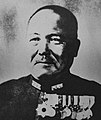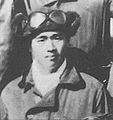Battle of the Coral Sea
Jump to navigation
Jump to search
English: The Battle of the Coral Sea was a naval battle of the Pacific Campaign of World War II, in early May 1942, and was one of the major turning points of the Pacific War.
Français : La bataille de la mer de Corail est une bataille navale de la campagne du Pacifique de la Seconde Guerre mondiale, début mai 1942, et qui fût un des tournants majeurs de la Guerre du Pacifique.
日本語: 珊瑚海海戦とは第二次世界大戦中の1942年5月7日から8日にかけて大日本帝国海軍の艦隊とアメリカ・オーストラリア連合軍艦隊が珊瑚海で戦った海戦。世界初となる航空母艦同士の海戦で、航空機が主役の戦いだった。
Polski: Bitwa na Morzu Koralowym była jedną z bitew morskich na Pacyfiku podczas II wojny światowej, którą stoczono na początku maja 1942 r. Bitwa ta stała się jednym z punktów zwrotnych wojny na Pacyfiku.
Српски / srpski: Битка у Коралном мору је била поморска битка у Пацифичкој Кампањи за време Другог светског рата, почетком маја 1942, и једна од главних прекретница у Пацифичком рату.
1942 major naval battle in the Pacific Theater of World War II | |||||
| Upload media | |||||
| Instance of | |||||
|---|---|---|---|---|---|
| Part of | |||||
| Location | Coral Sea | ||||
| Point in time |
| ||||
| Start time |
| ||||
| End time |
| ||||
 | |||||
| |||||
Allied forces
[edit]Overall commanders
[edit]-
US Admiral Chester Nimitz, commander of Allied forces in the Pacific
-
US Admiral Frank Jack Fletcher, commander of Task Force 17
Task Group (TG) 17.2 (Attack Group)
[edit]-
US Vice Admiral Thomas C. Kinkaid, commander of TG 17.2
-
USS Minneapolis
-
USS New Orleans
-
USS Astoria
-
USS Chester
-
USS Portland
-
USS Phelps
-
USS Dewey
-
USS Farragut
-
USS Aylwin
-
USS Monaghan
Task Group 17.3 (Support Group)
[edit]-
Royal Navy Rear Admiral John Gregory Crace, commander of TG 17.3
-
HMAS Australia
-
USS Chicago
-
HMAS Hobart
-
USS Perkins
-
USS Walke
Task Group 17.5 (Carrier Group)
[edit]-
US Vice Admiral Aubrey Fitch, officer in tactical command of TG 17.5
-
USS Yorktown
-
USS Lexington
-
USS Morris
-
USS Anderson
-
USS Hammann
-
USS Russell
Task Group 17.6 (Fueling Group)
[edit]-
USS Neosho
-
USS Tippecanoe
-
USS Sims
-
USS Worden
Task Group 17.9 (Search Group)
[edit]-
USS Tangier
Japanese forces
[edit]Overall commanders
[edit]-
Japanese Vice Admiral Shigeyoshi Inoue, commander of the Fourth Fleet/South Seas Force and overall commander of the Mo operation
Carrier Striking Force
[edit]-
Japanese Admiral Takeo Takagi, commander of the Carrier Striking Force
-
Japanese Vice Admiral Chūichi Hara, officer in tactical command of Carrier Division 5 (Shōkaku and Zuikaku)
-
Shōkaku
-
Zuikaku
-
Myōkō
-
Haguro
-
Ushio
-
Akebono
-
Ariake
-
Yugure
-
Shiratsuyu
-
Shigure
Not shown: Oiler Toho Maru
Tulagi Invasion Group
[edit]-
Japanese Rear Admiral Kiyohide Shima, commander of the Tulagi Invasion Group
-
Okinoshima
-
HIJMS Yūzuki
-
HIJMS Kikutsuki
Not shown: minelayer Koei Maru, transport Azumasan Maru, minesweepers Wa #1, Wa #2, Hagoromo Maru, Noshiro Maru #2, and Tama Maru, and subchasers Toshi Maru #3 and Tama Maru #8
Port Moresby Invasion Group
[edit]-
Japanese Admiral Sadamichi Kajioka, commander of the Port Moresby Invasion Group
-
Yubari
-
Mutsuki
-
Asanagi
-
Uzuki
-
Mochizuki
-
Yayoi
-
Oite
Not shown: 2 patrol boats/auxiliaries
Transport Unit
[edit]-
Kōsō Abe (center), commander of the Port Moresby Invasion Group's Transport Unit
-
Tsugaru
Not shown: 12 transports and various auxiliary craft
Support Group/Close Cover Force
[edit]-
Tenryu
-
Tatsuta
-
Kamikawa Maru
Not shown: Support Group commander Kuninori Marumo, and gunboats Keijo Maru, Seikai Maru and Nikkai Maru
Covering Group
[edit]-
Japanese Rear Admiral Aritomo Goto, commander of the Covering Group and Cruiser Division 6 (Aoba, Kako, Kinugasa, Furutaka)
-
Shōhō
-
Aoba
-
Kako
-
Kinugasa
-
Furutaka
-
Sazanami
Maps
[edit]-
Map of Imperial Japanese advances December 1941 - April 1942.
-
World War II Pacific theater in August, 1942.
-
Pacific Ocean divided up into WWII Allied commands.
-
South Pacific, 1942.
-
Location of Coral Sea
-
Map of southwest Pacific area in 1942-1943.
-
Strategic situation in South Pacific, summer 1942. Red circles are Japanese bases. Blue arrows are Allied shipping and communication lines between U.S. and Australia and New Zealand.
-
Allied lines of communication in the South Pacific, 1942.
-
Map of the Solomon and Santa Cruz Islands.
-
Map of Papua New Guinea
-
The Coral Sea area in 1942.
-
Solomon and Santa Cruz Islands and New Caledonia area, 1942.
-
Geographic map of the Coral Sea
-
Japanese and English map of the battle
-
Battle Map
-
Battle map in french
-
animated map of the battle
-
Map of the battle
-
Map of movement of part of Japanese forces during the battle.
-
Map of Coral Sea and Midway battles
Prelude
[edit]-
Two Lexington Wildcat fighters photographed in April 1942.
-
Yorktown launching aircraft sometime in April 1942. The presence of the oiler near Yorktown indicates that this picture was taken some time before the battle.
-
Sunrise or sunset over Yorktown's flight deck while operating in the Coral Sea in April 1942.
-
US tanker Neosho refuels Yorktown on 1 May 1942
-
A wave washes over Neosho as it refuels Yorktown in heavy seas prior to the battle.
-
Crews work on aircraft on the Zuikaku east of the Solomon Islands on May 5, 1942.
-
Photo of a Kamikawa Maru seaplane, possibly taken at Deboyne islands before or during the battle.
Tulagi
[edit]-
Aerial view of southeast end of Tulagi, showing prison, August 7, 1942.
-
Officers and petty officers of the 3d Kure Special Naval Landing Force which seized Tulagi and Gavutu in May 1942. The majority of these Japanese subsequently died defending their capture against U.S. Marines.
-
Japanese cargo ship Koei Maru is straddled by bombs dropped from aircraft from the USS Yorktown in Tulagi harbor on May 4, 1942. The ship escaped without serious damage.
-
Japanese cargo ship Koei Maru is straddled by bombs dropped from aircraft from the USS Yorktown in Tulagi harbor on May 4, 1942. The ship escaped without serious damage.
-
Japanese destroyer Yuzuki flees Tulagi harbor on May 4, 1942 in an attempt to evade air attack from U.S. carrier aircraft from the USS Yorktown.
-
U.S. Douglas SBD dive bombers return to the U.S. carrier Yorktown after attacking Japanese ships in Tulagi harbor on May 4, 1942.
Carrier battle 7-8 May
[edit]May 7
[edit]-
Japanese dive bombers on their way to attack US Navy ships on May 7.
-
Neosho burning and sinking after the attack by Japanese carrier dive bombers.
-
Shoho under attack on 7 May.
-
Torpedo hit on Shoho, 7 May.
-
Diagram of damage to Shoho.
-
Yorktown dive bomber and torpedo plane squadron leaders.
-
James Flatley, a Yorktown Wildcat fighter pilot who participated in the attack on the Japanese late afternoon strike mission.
-
TG17.3 under air attack.
-
TG17.3 under air attack.
May 8
[edit]-
Photo of Lexington early on the morning of 8 May just prior to launching first strikes against the Japanese carriers.
-
Lexington underway early on the morning of 8 May.
-
Lexington underway early on the morning of 8 May.
-
A Type 97 torpedo plane takes off from Zuikaku on 8 May.
-
A Type 99 dive bomber takes off from Zuikaku on 8 May.
-
Shokaku under attack on 8 May.
-
Shokaku under attack on 8 May.
-
Shokaku under attack on 8 May.
-
Lexington under carrier air attack as photographed from a Japanese aircraft.
-
Lexington under attack.
-
Lexington burning after taking hits from Japanese air attack.
-
Lexington burning after taking hits from Japanese air attack.
-
Effects of a hit on Lexington gun gallery during battle of coral sea
-
Damage to Lexington's flight deck from a bomb hit.
-
Damage to Lexington's flight deck during the battle.
-
Damage to Lexington gun gallery.
-
Lexington recovers aircraft after the Japanese air attack.
-
Lexington after the Japanese air attack and after recovering aircraft
-
Lexington torpedo damage.
-
Lexington's crew gathers on the flight deck in preparation for abandoning ship after the large explosion
-
The USS Lexington being abandoned during the Battle of the Coral Sea
-
Abandonment of the USS Lexington
-
Abandonment of the USS Lexington
-
Lexington crewmen abandon the ship from the stern.
-
Explosion aboard the Lexington
-
Explosion aboard the Lexington
-
Large explosion on Lexington
-
Lexington burns and explodes
-
Lexington burns and explodes
-
USS Lexington burning and abandoned
-
USS Lexington survivors
-
John James Powers, a Yorktown dive bomber pilot, was awarded the Medal of Honor for giving his life while making the second bomb hit on Shokaku.
-
US Navy Lieutenant Milton Ernest Ricketts was posthumously awarded the Medal of Honor for his actions in helping contain damage to Yorktown during the battle.
-
Diagram of hits taken by Lexington during the battle
-
Tetsuzo Iwamoto, one of the IJN's top fighter aces of the Pacific War, flew a Zero from Zuikaku during the battle.
-
Flying from Shokaku, Zero fighter pilot Sadamu Komachi claimed two wildcats and a dive bomber destroyed.
-
Flying from Shokaku, Zero fighter pilot Kenji Okabe claimed three wildcats and three dive bombers destroyed.
-
Zuikaku dive bomber group commander Tamotsu Ema, whose kanbaku damaged the Yorktown on May 8.
Aftermath
[edit]-
Japanese newspaper propaganda cartoon printed on May 13, 1942 depicting Japanese victory claims from the battle.
-
A Type 97 carrier bomber from Shokaku lies wrecked on Indispensable Reef
-
Damage to Shokaku.
-
Damage to Shokaku.
-
Damage to Shokaku.
-
Damage to Shokaku.
-
Shokaku's elevator dislodged from bomb hit.
-
Damage to Shokaku's anchor chains.
-
Damage to Shokaku, near the bridge from third bomb hit.
-
Damage to Shokaku's forward flight deck.
-
Damage to Shokaku's boat deck from second bomb hit.
-
Repair crew works on damage to Shokaku's boat deck after the battle.
-
Damage to Yorktown from bomb hit suffered during the battle.
-
Damage to Yorktown from bomb hit suffered during the battle.
-
Yorktown undergoing emergency repairs at Pearl Harbor after the battle in order to be available to defend Midway.
-
USS Astoria arrives at Pearl Harbor after the battle.
-
The airfield at Lunga Point on Guadalcanal, later called Henderson Field by the Allies, seen under construction by the Japanese in July, 1942.
-
Remains of Japanese destroyer Kikutsuki, destroyed by U.S. carrier aircraft on May 4, 1942 on Tulagi island photographed in August, 1943.
































































































































































